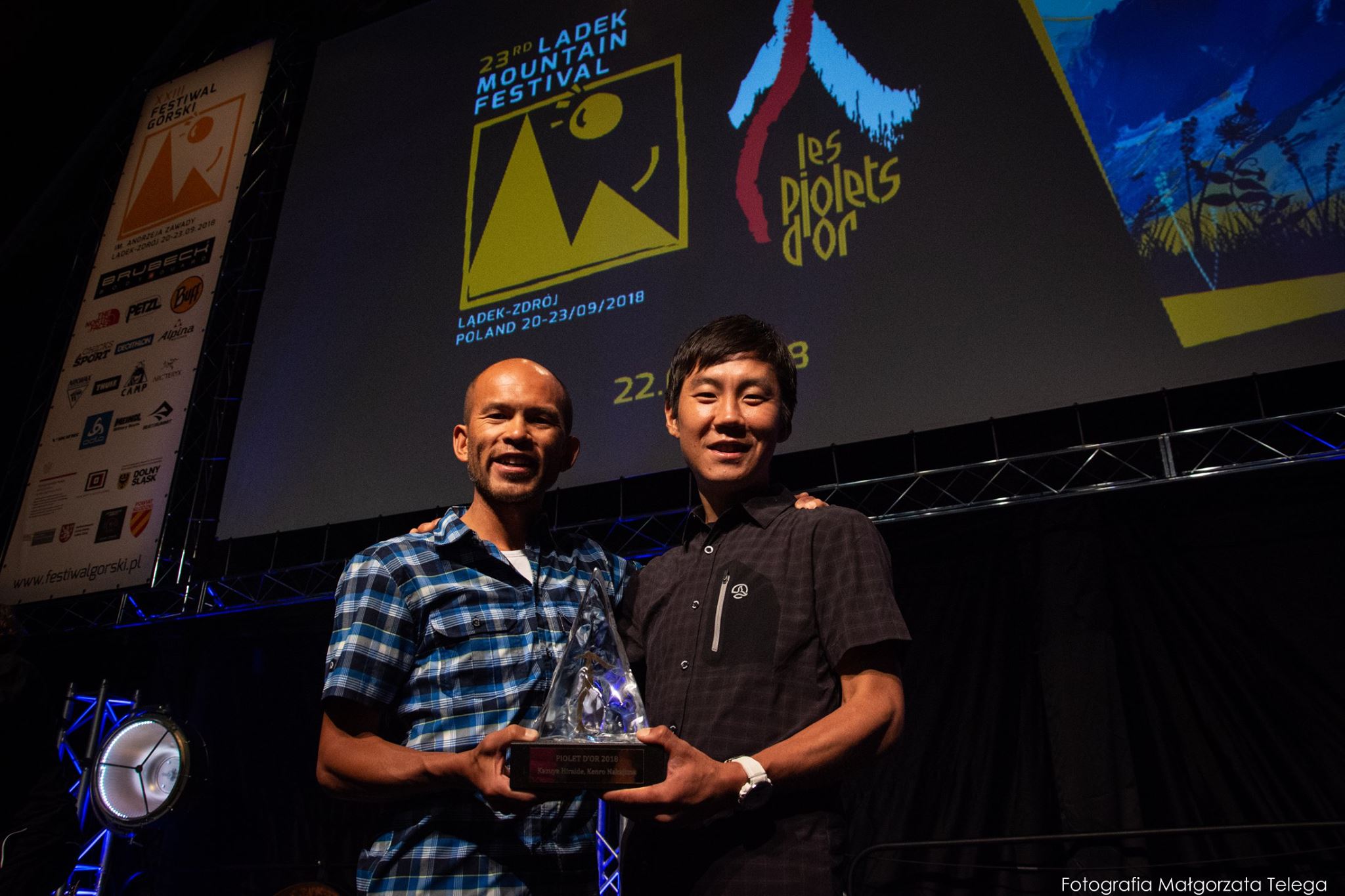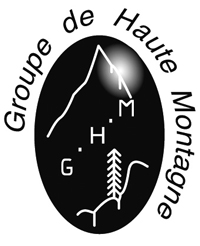©Piotr Drożdż
“For me, climbing is about carving out my own path, not following somebody else’s route.”
Kazuya Hiraide
The west face of K2 (8,611 m) is one of those legendary walls shrouded in mystery. The steepest face on the world's second highest mountain is over 3,000m high and has only been climbed once before in 2007 by a Russian expedition led by Vikor Kozlov who spent over 70 days on it using a lot of fixed ropes. Intertwined with vertical cliffs and menacing seracs, it was bound to attract the best alpine-style climbers. It became the dream and main objective of two of the best Japanese climbers of the last two decades, Kazuya Hiraide and Kenro Nakajima.
The eldest, Hiraide, aged 45, is well known to the alpine community and more particularly to the Piolets d'Or. In 2001, he made the first ascent of Kula Kangri East Peak (7,381m) in Tibet and climbed Cho Oyu, his first of five 8,000m summits, and then skied back down. Hiraide also won an award at the Asian ski-mountaineering championships. He went on to form an emblematic mixed-rope party in alpine style with his female compatriot Kei Taniguchi with first ascents on the northwest Ridge of Spantik (7,027m), the east face of Lila Peak (6,200m), Pakistan (2004), the east ridge of Mustagh Ata (7,564m), China (2005), first ascent on the north face and northwest ridge of Shivling (6,543m), India (2005), first ascent of the southeast face of Kamet (7,756m), India (2008). This last one, called Samurai Direct (1,800m, M5+ AI5), was recognised with a Piolet d'Or in 2009, the first awarded to Japanese climbers and also to a woman. They continued in 2011 with the southwest Ridge of the South Summit (7,200m) of Naimonanyi (7,694m) in China, then the west ridge of Jul Diran (7,266m) in Pakistan in 2013. Taniguchi's tragic death on Mount Kurodake in Hokkaido (Japan) in 2015 was the only blow to their partnership.
Nakajima, 39, has been making his mark in the Himalaya since 2006 (first ascent of Panbari Himal (6,905m) and then the south face of Mar Dingjung Ri (6,196m)). From 2014, he teamed up with Hiraide: "We often climb together but we are different climbers. Hiraide has more experience, whereas I'm technically stronger, although that's just my opinion of course. This means that I'm usually in the lead, while Hiraide follows me and keeps an eye on me. When I make a mistake, he tells me. It's difficult to be in the lead, but he also has a big responsibility behind me."
In 2015, the team (with Takuya Mitoro) climbed the north face of Api (7,132m) in Nepal. Then in 2017, the two men hit it big in Pakistan. Shispare (7,611m) is one of the highest peaks in the Batura Muztagh above the Hunza valley, an Ismaili enclave in northern Pakistan. While its name may only familiar to specialists, the beauty and purity of its immense 2,700m unspoilt northeast face are striking. Since 2007, Hiraide has already attempted Shispare three times, including once via this northeast face but only twice in all. They chose a line on the left-hand side of the face that skilfully avoided the large central seracs and the pyramid of the final rock bastion. Hiraide and Nakajima went up to bivouac at 5,450 metres at the foot of the face and, the following day, climbed vast glacial and mixed slopes up to 6,500m. It then took them a whole day to climb 350 metres, including some very steep ice traverses (M6 WI5). Bad weather then stopped them for a day and Nakajima began to show signs of altitude sickness. Nevertheless, they continued in deep snow and reached the summit before retracing their steps by compass. In memory of Kei Taniguchi, Hiraide buried her photo at the summit. For this ascent, they receive one of the Piolets d'Or 2018, the second for Hiraide.
In 2019, the duo was back in Hunza country on Rakaposhi (7,788m) on the south face and southeast ridge, an immense route, 4,000m high. While the technical difficulties are not exceptional, the adventure is total, on an isolated and little-frequented face. A new Piolet d'Or has been awarded in recognition of the values set out in the Piolets d'Or charter. In 2023, still in Pakistan, they reached the summit of Tirich Mir (7,708m) via a new route on the hitherto unexplored north face. Nakajima points out: "The north face, as if surrounded by a fortress, remained silent. To stand at its base, you have to climb from an unknown valley to a pass at 6,200m, then descend through an unknown valley to finally stand on the starting line. I love this kind of exploratory climbing! "
In 2017, after their ascent of Shispare, they walked to K2 to study its west face and identify a possible line. As Hiraide noted at the time: "By accumulating experience and taking small steps, I can turn the impossible into the possible. I’ve always tried to climb mountains like this so, even if it takes me 20 years to accomplish the impossible, it’s still fun. That’s what the west face is all about." In the summer of 2024, they were finally ready to take up their challenge: "The probability of succeeding is low. Our first goal is not to reach the summit, but to discover a world we don't yet know." On 27th July, having already reached 7,500m, the team fell more than a thousand metres. A helicopter managed to spot them, but the two climbers gave no sign of life and their bodies remained motionless. Their position and the weather conditions meant that they could not be approached either by air or by land, and it soon became clear that they would not be returning from their ultimate dream. As Hiraide had said before their departure: " In my heart, I have expectations, hopes, worries, fears…I can’t narrow it down to just one word."
Takuya Mitoro was their friend : " Until recently, climbing with expedition style was almost exclusively a Japanese domain. As the alpine style gained popularity, Kazuya and Kenro were pioneers and leading figures in Japan. They continually sought out climbs that no one had attempted before, dreaming of mountains that no one had seen. They strived for climbs that only they could accomplish. They achieved their pioneering challenges, earning high acclaim worldwide. They were truly heroes of the Japanese mountaineering community.
As mountaineering photographers, they were also artists who expressed "their extreme climbing". Balancing high-level climbing and photography is extremely difficult. Yet, they demonstrated advanced photographic techniques in extreme conditions in the mountains. Through their videos, they shared a harsh yet precious world with many people.
Even in the self-satisfying pursuit of climbing, they were also grateful to the people who supported them.They felt it was their mission to give back to those who supported them by climbing mountains. They have many fans and supporters, even those who have never climbed a mountain."
At a time when mountaineering had become less popular in Japan, "There is no doubt that they contributed to its revival. And they loved their families. If they had continued to climb higher and harder, would they have gone on to this end? Neither of the two great mountaineers could have eliminated that possibility. But we should remember that they loved mountaineering and made people happy through it.
I pray that these two outstanding mountaineers and friends of mine may rest in peace."














